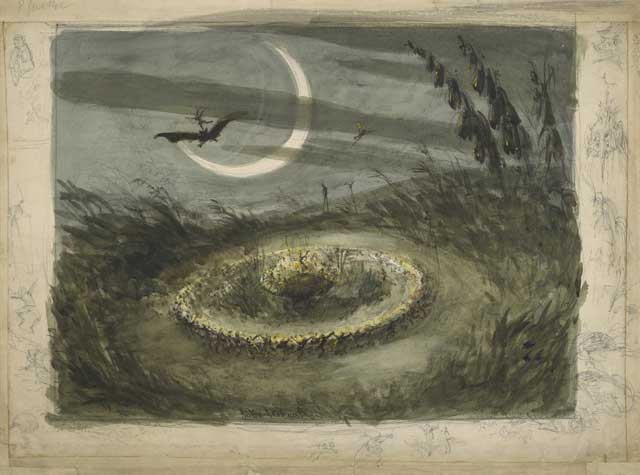Great Works: A Fantasy, The Fairy Ring (c1850), George Cruikshank
British Museum, London

Your support helps us to tell the story
From reproductive rights to climate change to Big Tech, The Independent is on the ground when the story is developing. Whether it's investigating the financials of Elon Musk's pro-Trump PAC or producing our latest documentary, 'The A Word', which shines a light on the American women fighting for reproductive rights, we know how important it is to parse out the facts from the messaging.
At such a critical moment in US history, we need reporters on the ground. Your donation allows us to keep sending journalists to speak to both sides of the story.
The Independent is trusted by Americans across the entire political spectrum. And unlike many other quality news outlets, we choose not to lock Americans out of our reporting and analysis with paywalls. We believe quality journalism should be available to everyone, paid for by those who can afford it.
Your support makes all the difference.The fairies? It sounds a bit like that. T S Eliot imagines his figures in his poem "East Coker", in a country setting, remote and haunted.
"In that open field
If you do not come too close, if you do not come too close,
On a summer midnight, you can hear the music
Of the weak pipe and the little drum And see them dancing around the bonfire ...
Round and round the fire
Leaping through the flames, or joined in circles,
Rustically solemn or in rustic laughter..."
These words certainly cast up a midsummer mood. But they don't need to convey any magic realm. A folk ritual is all it suggests. And then there are twee little creatures, butterfly-winged and smiley, conjured up in many Victorian paintings; or indeed in the affair of the Cottingley Fairies, faked photographs produced in 1917 by two young girls, and taken up in quasi-scientific psychical research by Sir Arthur Conan Doyle.
But there are also images where you can find wilder and darker fairies. For instance, look at George Cruikshank's A Fantasy, the Fairy Ring. Here, within the margin of drawn frogs and goblins, his vision is sketched out. And whatever his real belief may be, this illustrator shows a truly mysterious experience, imaging something excitingly extra-sensory.
It is growing dusk. It is on the crest of a hill. It is the spooky evening sky, and the ground is at a deep slant. Nodding foxgloves stand to one side. Dark grasses are combed around a centre. There is a bat flying at an angle, and the little hopping elf is on his back, and smaller elves still are visible. This is where we find the spot where the magical ring is set on the earth.
The airs are gathering. The clouds are dashing across the sky. And above the ridge of the land, there is a large crescent moon, almost as new as can be. It makes an echo between sky and earth – that is, between the round edge of the moon and the round edge of the fairy ring. And the action is now in the middle of the dance.
There is a ring within a ring. In its heart there is the fairy queen, while the outer creatures are thrown about and about. These seeds are like black flung criss-cross miniatures. These dancers are in whirling, running motion. These spinners rotate, and turn on a counter-clockwise "widdershins" tub. The energy of this ring creates a glow and a hum and a blur, and it goes so quickly and so roundly that it cuts an empty clearing in the grass, like a tonsure in the ground.
So it becomes an extreme fairy world. Our view looks right down upon its dimensions. We are far from being amongst them, and we have no inclination to identify with them. On the contrary, these individual creatures have their alien element, and we are unable to inhabit their existence. Their lives are something weird, hard to grasp, beyond our touch or our sight – below our perception, beneath our threshold of sense.
This wild fairy world, as imagined here, could be compared to the sub-perceptual world of bats. And both spinning fairies and swimming bats coexist in it. So it might make a soundtrack for this extraordinary poem by Les Murray, Bat's Ultrasound: "Where they flutter at evening's a queer / tonal hunting zone above highest C". The words of its final verse are almost impossible to read on the page. But if you read them aloud, their spell will carry them into the air.
Ah, eyrie-ire; aero hour, eh? O'er our
ur-area (our era aye ere your raw
row) we air our array
err, yaw, row wry-aura our orrery, our eerie ü our ray, our arrow. A rare ear, our aery Yahweh.
ABOUT THE ARTIST
George Cruikshank (1792–1878) was an English caricaturist and illustrator. Very popular in his lifetime, he came to supplant Gillray in the English imagination. Known for his violently patriotic and racist images, portraying the Irish as apes, he was the illustrator of Dickens
Join our commenting forum
Join thought-provoking conversations, follow other Independent readers and see their replies
Comments